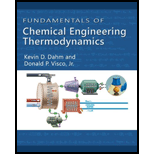
Interpretation:
To calculate the change in enthalpy and entropy of the given system assuming ideal gas model.
Concept introduction:
The enthalpy during mixing remains constant and considering the gas as an ideal gas, the pressure change also has no effect on the enthalpy. It may seem like the change in enthalpy is zero, but since the temperature changes and enthalpy being a function of temperature also changes.
Similarly entropy during the mixing process remains constant and is also a function of temperature as well as pressure. Hence to know the entropy change, both the final pressure and temperature after mixing is required.
Explanation of Solution
The energy balance equation for the gas system on both sides of the partition is:
Here, initial and final internal energy is
Being a closed adiabatic system with rigid boundaries, the internal energy of blending is 0, so:
Here, vapor phase mole fraction of argon and nitrogen is
The internal energy of argon and nitrogen which is not known at the moment must be calculated at the last temperature. Adding this into the energy balance:
Here, total number of moles is N.
Substitute the value of
There are 2.5 moles of argon and 112 g of nitrogen.
The value of
Here, number of moles in nitrogen and argon is
Substitute 4 mol for
The value of
Substitute 0.615 for
On modelling argon a monoatomic gas into an ideal gas, it has
Here, heat capacity at constant volume is
Substitute
Referring to Appendix D, “ideal gas heat capacity”, the value of ideal gas heat capacity at constant pressure is obtained as:
Here, constants are A, B, C, D, and E, and gas constant is R.
The ideal gas heat capacity at constant volume is:
Substitute
The difference of molar internal energy of both gas is written as:
Substitute
From Equation (2),
Substitute 0.385 for
Referring to Appendix D.1, “Ideal gas heat capacity”, the parameters A, B, C, D, and E for nitrogen are obtained and are given in Table (1).
| Compound | A | ||||
| Nitrogen | 3.539 | –0.261 | 0.007 | 0.157 | –0.099 |
Substituting
At this stage, we are able to find the enthalpy change in argon and nitrogen. Since there is no enthalpy change during mixing, the total of these two changes in enthalpy gives the enthalpy of the system.
Here, change in enthalpy of argon is
Substitute 2.5 mol for
Substitute
The change in enthalpy of nitrogen is calculated as:
Substitute 4 mol for
Substituting
The total change in enthalpy of system is:
Substitute 1747 J for
The change in enthalpy of the system is
This is a minimal change in enthalpy but it is not zero. From this it can be seen that even if
Use ideal gas equation to find the final pressure.
Here, final temperature and volume is T and V respectively.
On removing the partition, the volume of the system does not change and the total volume is the sum of the individual volume of argon and nitrogen.
Here, initial pressure and temperature of argon and nitrogen is
Substitute 2.5 mol for
Substitute
The change in entropy is calculated as:
Here, molar entropy of argon and nitrogen is
Substitute 6.5 moles for N in Equation (8).
The final molar entropy for an ideal gas mixture is calculated as:
Substitute the value of
This accounts for two thing namely the change in entropy of argon and nitrogen due to pressure and temperature and the entropy of mixing the aspect of mixing in equation (10) is:
Substitute
The change in entropy for a pure ideal gas is expressed as:
Here, change in molar volume is
The
Substitute
Substitute
For nitrogen
Substitute
From Equation (10),
Substitute
Hence, the change in entropy is
Want to see more full solutions like this?
Chapter 9 Solutions
Fundamentals of Chemical Engineering Thermodynamics (MindTap Course List)
 Introduction to Chemical Engineering Thermodynami...Chemical EngineeringISBN:9781259696527Author:J.M. Smith Termodinamica en ingenieria quimica, Hendrick C Van Ness, Michael Abbott, Mark SwihartPublisher:McGraw-Hill Education
Introduction to Chemical Engineering Thermodynami...Chemical EngineeringISBN:9781259696527Author:J.M. Smith Termodinamica en ingenieria quimica, Hendrick C Van Ness, Michael Abbott, Mark SwihartPublisher:McGraw-Hill Education Elementary Principles of Chemical Processes, Bind...Chemical EngineeringISBN:9781118431221Author:Richard M. Felder, Ronald W. Rousseau, Lisa G. BullardPublisher:WILEY
Elementary Principles of Chemical Processes, Bind...Chemical EngineeringISBN:9781118431221Author:Richard M. Felder, Ronald W. Rousseau, Lisa G. BullardPublisher:WILEY Elements of Chemical Reaction Engineering (5th Ed...Chemical EngineeringISBN:9780133887518Author:H. Scott FoglerPublisher:Prentice Hall
Elements of Chemical Reaction Engineering (5th Ed...Chemical EngineeringISBN:9780133887518Author:H. Scott FoglerPublisher:Prentice Hall
 Industrial Plastics: Theory and ApplicationsChemical EngineeringISBN:9781285061238Author:Lokensgard, ErikPublisher:Delmar Cengage Learning
Industrial Plastics: Theory and ApplicationsChemical EngineeringISBN:9781285061238Author:Lokensgard, ErikPublisher:Delmar Cengage Learning Unit Operations of Chemical EngineeringChemical EngineeringISBN:9780072848236Author:Warren McCabe, Julian C. Smith, Peter HarriottPublisher:McGraw-Hill Companies, The
Unit Operations of Chemical EngineeringChemical EngineeringISBN:9780072848236Author:Warren McCabe, Julian C. Smith, Peter HarriottPublisher:McGraw-Hill Companies, The





